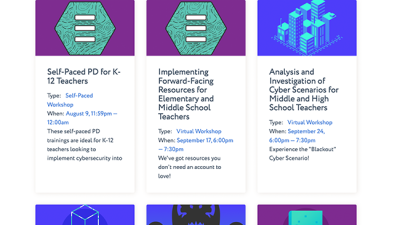Cyber connections can arise throughout a student’s learning journey – from history classes covering the World War II encryption machines to cybersecurity classes preparing students to take certification exams. K-12 is ripe with opportunities to integrate cyber education into all subject areas and grade levels.
Cyber Connections
Exploring how cyber connections can lead to students experiencing lightbulb moments in a variety of K-12 settings

For some teachers, the word “cyber” is familiar and comfortable. For others, it may be new and intimidating. Our curricula writers and trainers aim to meet all K-12 educators wherever they are in their experience level in cyber education by uncovering connections to what they are already teaching. Cyber connections can arise throughout a student’s learning journey – from history classes covering the World War II encryption machines to cybersecurity classes preparing students to take certification exams. K-12 is ripe with opportunities to integrate cyber education into all subject areas and grade levels.
We use the word cyber to refer to all electronic devices that interact with networks (from robots and laptops to cell phones and the Internet of Things). Within cyber, cybersecurity refers to the people, processes, and technology involved in protecting digital assets (connected devices and the data they contain) from unauthorized access. Together, these two terms encompass the content covered by our curricula and professional development workshops. In fact, when you’re browsing our curricula on CYBER.ORG you can check to see what cyber connections are made in a course or unit!

One thing we know is this: having a good grip on cyber topics improves employment prospects, digital hygiene, and national cybersecurity.
At CYBER.ORG, we see value in arming students with these assets early and regularly in their educational lives through an integrated approach. The more students that graduate with foundational cyber and technical cybersecurity competence, the more cyber-aware our nation will be, and the more robust we can build our cybersecurity workforce.
Over the next few months, we’ll be exploring cyber connections in a series of blog posts. We’ll hear from a variety of perspectives on how cyber connects to K-12 classrooms, private industry, home life, and our government. Most importantly, we’ll explore how those connections can culminate with a student experiencing a lightbulb moment, imagining for themselves a bright future working in cyber.



